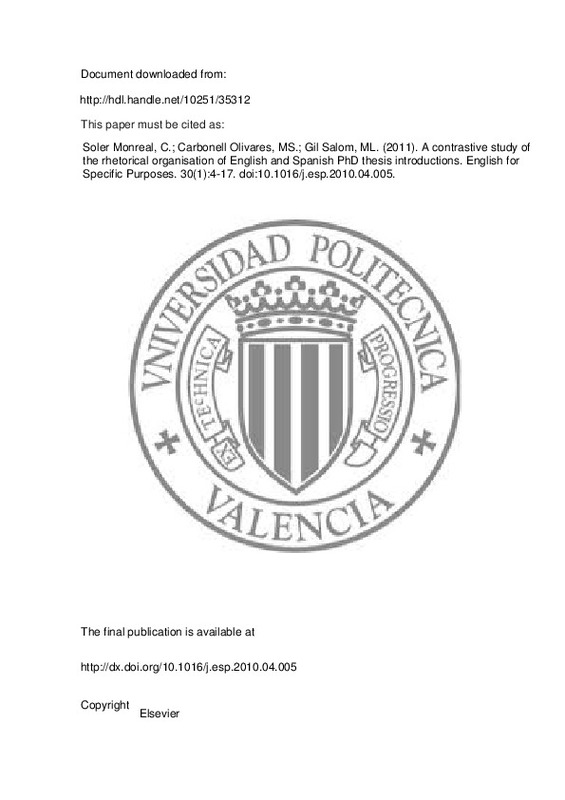JavaScript is disabled for your browser. Some features of this site may not work without it.
Buscar en RiuNet
Listar
Mi cuenta
Estadísticas
Ayuda RiuNet
Admin. UPV
A contrastive study of the rhetorical organisation of English and Spanish PhD thesis introductions
Mostrar el registro sencillo del ítem
Ficheros en el ítem
| dc.contributor.author | Soler Monreal, Carmen
|
es_ES |
| dc.contributor.author | Carbonell Olivares, María Soledad
|
es_ES |
| dc.contributor.author | Gil Salom, María Luz
|
es_ES |
| dc.date.accessioned | 2014-02-03T08:57:17Z | |
| dc.date.issued | 2011-01 | |
| dc.identifier.issn | 0889-4906 | |
| dc.identifier.uri | http://hdl.handle.net/10251/35312 | |
| dc.description.abstract | This paper presents an analysis of the introductory sections of a corpus of 20 doctoral theses on computing written in Spanish and in English. Our aim was to ascertain whether the theses, produced within the same scientific-technological area but by authors from different cultural and linguistic backgrounds, employed the same rhetorical strategies to introduce the work presented. The analysis follows the Swalesian approach and is based on a move/step/sub-step model proposed for PhD introductions in Spanish (Carbonell-Olivares, Gil-Salom, & Soler-Monreal, 2009). The Spanish academic conventions appear to be that move 1 (M1- Establishing the Territory) and move 3 (M3- Occupying the Niche) are obligatory moves in PhD thesis introductions in Spanish, while move 2 (M2- Establishing the Niche) is optional. The structure of English thesis introductions reveals that they conform more closely to the M1-M2-M3 arrangement. Moreover, combinations of moves and patterns, cyclicity and embedding make their organisation more complex. The step analysis suggests that introductions in both languages rely mainly on the presentation of background information and the work carried out. However, the English introductions tend to stress the writer's own work, its originality and its contribution to the field of study. They also present more embedding and overlapping of steps and sub-steps than the Spanish texts. © 2010 Elsevier Ltd. | es_ES |
| dc.format.extent | 14 | es_ES |
| dc.language | Inglés | es_ES |
| dc.publisher | Elsevier | es_ES |
| dc.relation.ispartof | English for Specific Purposes | es_ES |
| dc.rights | Reserva de todos los derechos | es_ES |
| dc.subject | Academic writing | es_ES |
| dc.subject | Computing | es_ES |
| dc.subject | Contrastive rhetoric | es_ES |
| dc.subject | Doctoral thesis | es_ES |
| dc.subject | Genre analysis | es_ES |
| dc.subject | Intercultural rhetoric | es_ES |
| dc.subject | Introduction | es_ES |
| dc.subject.classification | FILOLOGIA INGLESA | es_ES |
| dc.title | A contrastive study of the rhetorical organisation of English and Spanish PhD thesis introductions | es_ES |
| dc.type | Artículo | es_ES |
| dc.identifier.doi | 10.1016/j.esp.2010.04.005 | |
| dc.rights.accessRights | Abierto | es_ES |
| dc.contributor.affiliation | Universitat Politècnica de València. Departamento de Lingüística Aplicada - Departament de Lingüística Aplicada | es_ES |
| dc.description.bibliographicCitation | Soler Monreal, C.; Carbonell Olivares, MS.; Gil Salom, ML. (2011). A contrastive study of the rhetorical organisation of English and Spanish PhD thesis introductions. English for Specific Purposes. 30(1):4-17. doi:10.1016/j.esp.2010.04.005 | es_ES |
| dc.description.accrualMethod | S | es_ES |
| dc.relation.publisherversion | http://dx.doi.org/10.1016/j.esp.2010.04.005 | es_ES |
| dc.description.upvformatpinicio | 4 | es_ES |
| dc.description.upvformatpfin | 17 | es_ES |
| dc.type.version | info:eu-repo/semantics/publishedVersion | es_ES |
| dc.description.volume | 30 | es_ES |
| dc.description.issue | 1 | es_ES |
| dc.relation.senia | 39667 |







![[Cerrado]](/themes/UPV/images/candado.png)

